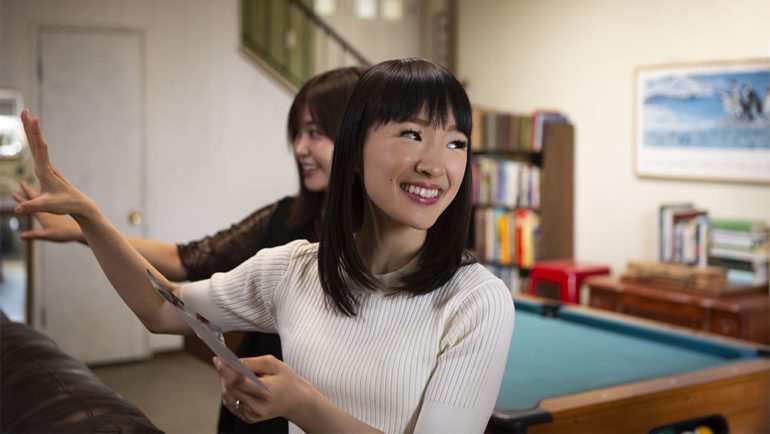TV Review: ‘Tidying Up With Marie Kondo’
By Daniel D’Addario
LOS ANGELES (Variety.com) – It’s hard to imagine a cannier choice of premiere date getting made in 2019 than the one happening on the year’s first day.
On Jan. 1 — that day of putting into practice optimistic resolutions and, sometimes, enduring a bit of self-flagellation over the excesses of the night before — Netflix releases the first season of “Tidying Up with Marie Kondo,” an eight-episode self-help reality show spotlighting the Japanese decluttering guru and her vaunted “KonMari” method.
Happily for those spending their New Year’s Day seeking a bit of uplift for the year ahead, Kondo makes decluttering seem within reach, and appealing, too. Better still for all television fans, she’s an amiable presence on a show that wears its status as an adaptation of her mega-hit book “The Life-Changing Magic of Tidying Up” lightly, a series that steers clear of overproduction in favor of the clean lines of classically-built home-improvement television.
Kondo enters the series under an umbrella held by her omnipresent Japanese-to-English translator; the resemblance to Mary Poppins, that other great life-renovating oddball, can hardly be presumed to be accidental. In each episode, she visits a different household to put into practice a relatively simple method of rules whose basicness (in short, objects must “spark joy” to be kept) was padded out with deeply specific rules of how to fold garments and linens in order to become a philosophy. Though the first episode is burdened with some too-stagey specificities — it’s about a family whose fights over laundry are played out in what at least feel like re-enactments — those fall away to make for a pleasant watch. Most of the show’s families, indeed, have stories that are told without overindulgence in specificity; instead, the reasons that their homes and lives are cluttered (grief, stress, the busyness of modern life) are big headlines that allow us to relate in broad strokes, without alienating details or time wasted.
It’s buoyed by Kondo, who is as pleasantly idiosyncratic as the “Queer Eye” guys, though intriguingly less knowable. Some of Kondo’s mystery — her refusal to indulge Jonathan Van Ness-style intimacy with her subjects or with the camera — may be due to the language barrier and more ineffable cultural differences between Kondo and the Americans whose stuffed-to-the-gills homes she gives some breathing room. More seems due to the particularities of Kondo, who has a tendency, on-air, to acknowledge her feelings in the moment and to let them go. In an early episode, she notes that finding a couple’s wedding pictures (buried under a pile of household garbage, naturally) makes her think about how she’s missing her husband, from whom she’s separated by her work on “Tidying Up” on their own wedding anniversary. The moment slips away, or is pushed; she tells her charges how glad she is to have found an artifact of theirs. For Kondo, the queen of “sparking joy,” moments of interaction are opportunities to create a feeling of comfort and happiness. Despite the difference in language, she’s in some ways a born host, leaning on both charisma and a drivenness to convert just about every moment with each episode’s messy family into something that feels both friendly and pleasantly (and bingeably) serene.
Kondo is so assiduously there to help — holding her subjects’ babies, flexibly accommodating un-KonMari-ish moments of high emotion into what is generally a rigorous method — that there’s little room for confession or for volubility, or for much feeling that diverges from a simple binary, joy and not-joy. That’s been pared away. What’s left is a figure who’s intriguingly hidebound when it comes to her rules and ever-so-gently passive-aggressive. (In one of her direct-to-camera explanations of her philosophy, she tells us, “Photos can be stored in a box. My recommendation is to store them in an album. This makes it easier to enjoy the memories.” Later in that episode, she smiles benevolently as she’s shown her charges’ newly organized boxes of photos.) I’ll admit to having long been a “KonMari” skeptic. It seems at times a set of rules that are either life-devouringly inane — Kondo’s style of folding is certainly efficient as regards space, but her telling one of her students that while it
seems
time-consuming, she actually does it with her daughter in place of reading bedtime stories, was startling — or just a way to end up with a justification to buy more stuff.
Credit to Kondo, then, for selling her method so well and with such élan, building out an optimistic vision that, for all its own idiosyncrasies, is shown to have some positive impact when placed into contact with that thing as messy as people. Kondo certainly seems to have something figured out, treading lightly as she does through the lives of so many sloppy Americans, with so much of their stuff in her way, and emerging from homes with newly revealed cornices, alluringly empty. The spareness of these homes, mirrored by the host who’ll soon vanish, allows the viewer to project almost anything onto them. Kondo has hit upon an ingenious formula for a show — if not, perhaps one that can sustain forever. But it suits a moment of mental clutter at which renewal seems like a dream worth indulging. In a medium so often governed by volume and aggressive presence, she leaves her mark through absence, through erasing. Her featherweight touch leaves space for the audience to imagine changes they might make in a year ahead that’s, in its first hours, as blank and open to possibility as a KonMari’d room.
“Tidying Up with .” , Jan. 1. Eight episodes (four screened for review).
Executive Producers: Gail Berman, Joe Earley, Hend Baghdady, Marie
Kondo
, Takumi Kawahara, and Bianca Barnes-Williams.

